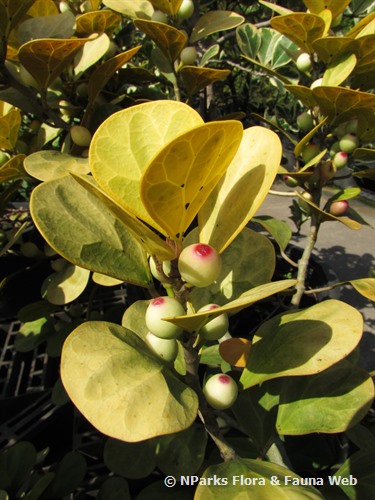
Name
Classifications and Characteristics
| Plant Division | Angiosperms (Flowering Seed Plants) (Dicotyledon) |
|---|---|
| Plant Growth Form | Tree (Big (>30m)), Shrub |
| Lifespan (in Singapore) | Perennial |
| Mode of Nutrition | Autotrophic |
| Plant Shape | Irregular |
Biogeography
| Native Distribution | Sumatra, Peninsular Malaysia, and Singapore |
|---|---|
| Native Habitat | Terrestrial (Freshwater Swamp Forest) |
| Preferred Climate Zone | Tropical |
| Local Conservation Status | Native to Singapore (Critically Endangered (CR)) |
Description and Ethnobotany
| Growth Form | It is a latex-containing, strangling fig up to 36 m tall, with few, slender aerial roots reaching the ground. |
|---|---|
| Foliage | Its spirally-arranged, short-stalked leaves have thickly leathery leaf blades that are almost flat, curved inwards, oblong, dark green, and 1.8–11 by 1–5 cm. |
| Flowers | The plant is dioecious with each plant bearing male or female flowers. The flowers are tiny and develop within the syconium (fig). |
| Fruit | Its round syconia (figs) are up to 4 mm wide, and develop in pairs at the leaf axils. It is rose-pink, with a swollen, and depressed or sunken opening at the apice (ostiole) when mature. |
| Habitat | It grows in forests at low altitudes. It occurs locally in the Western Catchment Area and vicinity of the Upper Pierce Reservoir. |
| Associated Fauna | Its flowers are pollinated by fig wasps. The ripe fruits are eaten by birds. |
| Cultivation | It can be propagated by seed, stem cuttings or air-layering. |
| Etymology | Latin Ficus, the commercial edible fig (Ficus carica); Latin micro, small; Latin syce, figs, referring to the plant’s small syconia (figs) |
| Ethnobotanical Uses | Others: It has horticultural potential as an ornamental plant. |
Landscaping Features
| Landscaping | It may be suitable for parks and along the edges of ponds. |
|---|---|
| Desirable Plant Features | Ornamental Fruits |
| Landscape Uses | General, Parks & Gardens, Small Gardens |
Fauna, Pollination and Dispersal
| Fauna Pollination Dispersal Associated Fauna | Bird-Attracting (Fruits) |
|---|---|
| Pollination Method(s) | Biotic (Fauna) (Insects (Ant, Beetle, Fly, Thrip, Wasp)) |
| Seed or Spore Dispersal | Biotic (Fauna) |
Plant Care and Propagation
| Light Preference | Full Sun, Semi-Shade |
|---|---|
| Water Preference | Moderate Water |
| Plant Growth Rate | Moderate |
| Rootzone Tolerance | Moist Soils, Well-Drained Soils |
| Propagation Method | Seed, Stem Cutting |
Foliar
| Foliage Retention | Evergreen |
|---|---|
| Mature Foliage Colour(s) | Green |
| Mature Foliage Texture(s) | Leathery |
| Foliar Type | Simple / Unifoliate |
| Foliar Arrangement Along Stem | Alternate |
| Foliar Attachment to Stem | Petiolate |
| Foliar Shape(s) | Non-Palm Foliage (Oblong) |
| Foliar Venation | Pinnate / Net |
| Foliar Margin | Entire |
Non - Foliar and Storage
| Root Type | Underground, Aboveground (Strangling Root) |
|---|
Floral (Angiosperm)
| Flower & Plant Sexuality | Unisexual Flowers , Monoecious |
| Flower Grouping | Cluster / Inflorescence |
|---|
| Flower Location | Axillary |
| Inflorescence Type | Syconium |
Fruit, Seed and Spore
| Mature Fruit Colour(s) | Pink |
|---|---|
| Fruit Classification | Multiple Fruit |
| Fruit Type | Fleshy Fruit , Accessory / False Fruit (Pseudocarp) |
Image Repository
Others
| Master ID | 31208 |
|---|---|
| Species ID | 5602 |
| Flora Disclaimer | The information in this website has been compiled from reliable sources, such as reference works on medicinal plants. It is not a substitute for medical advice or treatment and NParks does not purport to provide any medical advice. Readers should always consult his/her physician before using or consuming a plant for medicinal purposes. |







